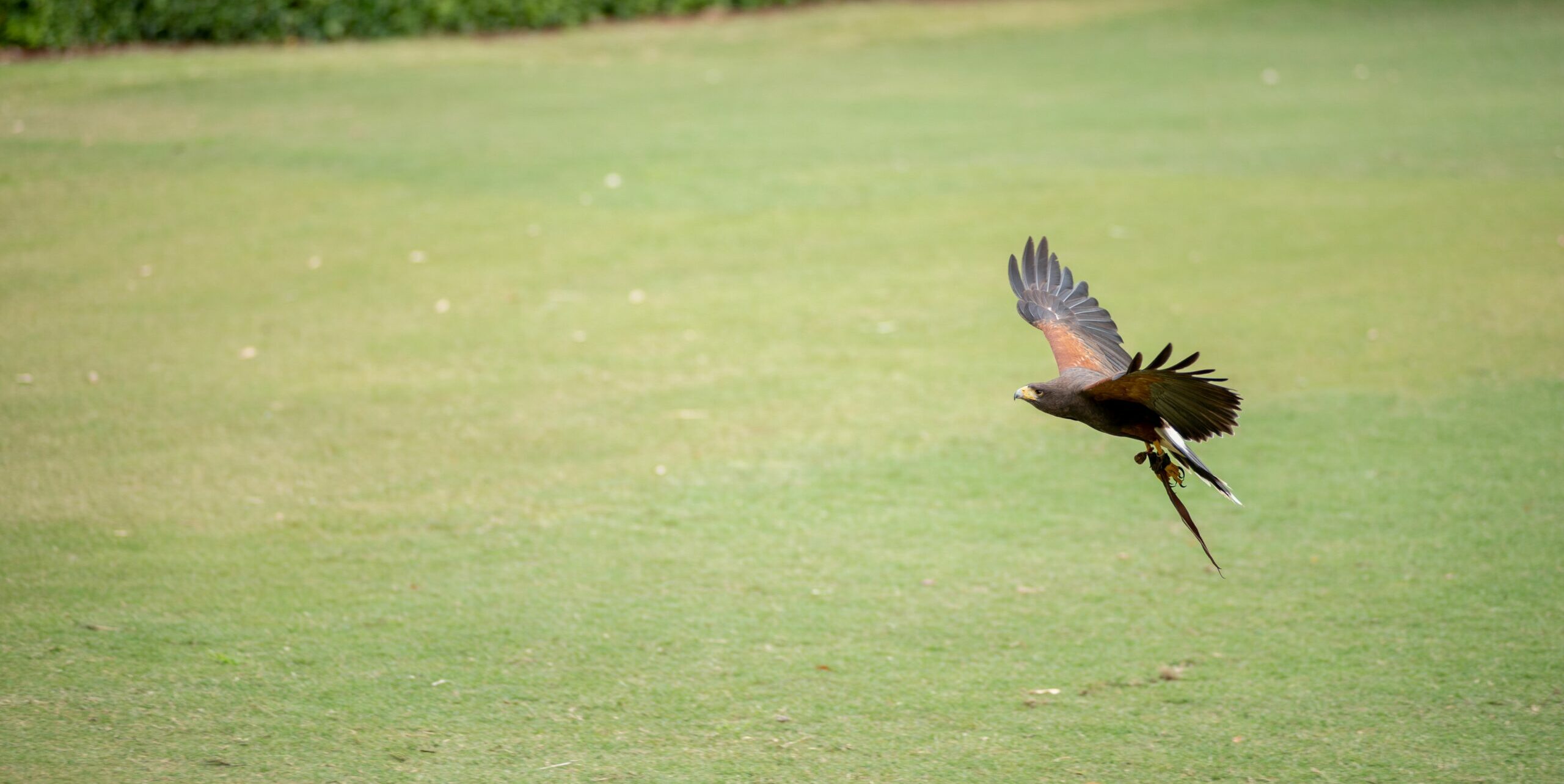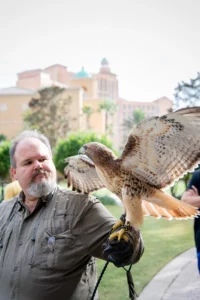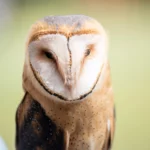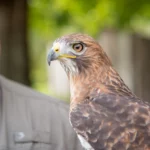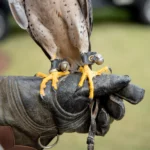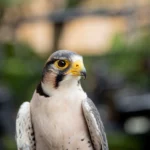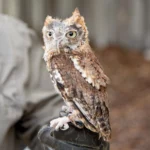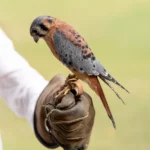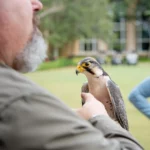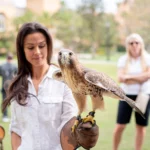Walk with a Hawk at the Grande Lakes Orlando Falconry School with Master Falconer Terry Arndt.
At 10 a.m. on a humid 89-degree Saturday in July, a majestic peregrine falcon, the fastest bird in the world, stands atop the branches of a lush tree along one of the 11 placid lakes and ponds in Grande Lakes, a 500-acre resort complex at the headwaters of the Florida Everglades in Orlando, Florida.
The astute bird scans and quickly spies its next perch, a gloved hand, and forearm with a piece of cow heart nestled between the thumb and index finger of Master Falconer Terry Arndt (see photo). As if on command, the yellow-beaked black and brown bird plummets and swoops in a perfect arc and in the blink of an eye lands on the falconer’s leather and suede glove.
The scene is one that has played out since at least the third millennium B.C., according to the North American Falconers Association. It’s a time-honored tradition that, in an effort to preserve the exhilarating sport, was added to UNESCO’s list of Intangible Cultural Heritages of Humanity in 2010.
As the peregrine falcon devours the morsel of meat in one gulp, it scans the horizon again as Arndt answers questions from a handful of falconry school students about the history of falconry, the basics of falconry, and life as a falconer.
Arndt is a Master Falconer who is the only falconer permitted to offer a hotel falconry course in Florida. For six years, he has taught the Walk with a Hawk class, the only one of its kind at a Florida hotel. The class at Grande Lakes, which is anchored by The Ritz-Carlton Orlando, Grande Lakes, JW Marriott Orlando, Grande Lakes, and Marriott’s Lakeshore Reserve timeshare, is licensed through the Florida Fish and Wildlife Conservation Commission.
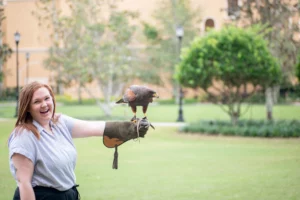

The resort also offers sunrise safaris via golf cart to observe wildlife like whitetail deer, bobcats, alligators, and owls, two-hour eco-tours of the 48-acre Shingle Creek waterway by canoe or kayak, and angling lessons from the resort’s fishing school and expedition service. Conservation and sustainability are hallmarks of the expansive property that includes 33 acres of protected habitat. Grande Lakes boasts several apiaries, Whisper Creek Farm, an onsite 18,000-square-foot farm, and employs six certified Florida Master Naturalists.
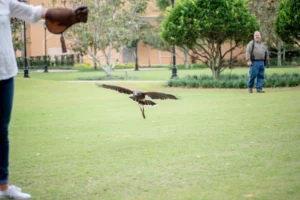

Falconry is just one of many unique classes offered at hotels across the U.S. Many hotels offer interactive classes to learn new skills like mermaid swimming at the Hyatt Regency Huntington Beach Resort and Spa in Huntington Beach, California. and fly-fishing at the Orvis Fly Fishing School at The Equinox Golf Resort & Spa in Manchester, Vermont, or time-honored traditions like indigo dyeing at Wild Dunes in Isle of Palms, South Carolina, and sailing at The Sailing Academy at the Inn at Perry Cabin in Saint Michaels, Maryland.
At the start of falconry school at Grande Lakes, the class of six students dives right into learning about the history of falconry. Then, after a discussion about the birds of prey, rules and regulations surrounding the “Sport of Kings,” how to handle a bird of prey, and a detailed rundown of the very real dangers of this cultural heritage art, Arndt gets ready to introduce a colorful kestrel.
Donning a thick black and brown glove that extends to the elbow, I readied for the experience of holding the falcon on the glove. With my left elbow firmly by my ribs, my left arm extended and my hand raised higher than my elbow as if pledging an oath, I readied to receive the small but mighty predatory bird.
Taking a deep breath, I pinched my thumb and index finger around the jess, a tether made of a thin leather strap that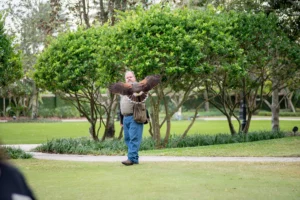

The kestrel firmly gripped my wrist and stood as still as a statue, scanning and surveying his surroundings. He was seemingly unconcerned about me and solely focused on finding prey.
Unlike an animal act or performance, this falcon, the smallest falcon in the U.S., is doing his natural job: hunting for wild quarry with the help of a human. As the trained raptor examined and considered our surroundings, I silently contemplated how this creature has evolved as a predator over millions of years. I also considered how, if I lost my grip, the falcon would most certainly immediately take flight, so I held on tighter.
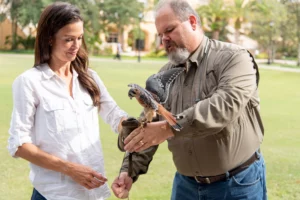

It’s an artistry that takes years to master and does not come without risk of injury or the possibility the falcon, hawk, or owl could fly away and never return.
Falconry is a highly regulated sport, the only one in the U.S. that incorporates a trained wild animal, that requires years of knowledge and skill-building and daily, diligent training and care, including daily weigh-ins and hunting exercises. Raptors are protected by state, federal, and international law, and falconers must have permits and obtain licenses before practicing falconry.
To become a Master Falconer, a person must apprentice for at least two years, practice for at least five years, and pass a written exam that tests knowledge of birds of prey, falconry laws, raptor biology, care, and husbandry.
The falconer’s role is to train the raptor to find and retrieve food. Long before most falconers trap their first hawk, eagle, owl, or falcon, they have to buy a variety of equipment like jesses and lures, provide a mews (indoor habitat) or weathering area (outdoor habitat) for their bird of prey, and pass inspections by authorities.
Maintaining the falcons is a daily job that requires hours of training. When they are first trapped, the birds are often hooded to eliminate visual stimulation. The falconer puts a permanent, numbered band from the U.S. Fish and Wildlife Service on its leg. The bird is weighed, given medical treatment, and conditioned. As the bird loses weight, it gets hungry. The falconer flies the birds at the edge of hunger, not starvation, which incentivizes them to respond to the falconer.
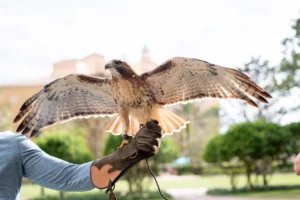

Falconry became a routine practice in many parts of the world because it was an effective way to provide food. In the Middle Ages, this field sport tradition became a popular pastime among aristocrats in Europe.
Christopher Columbus had at least one falconer on his ship that hunted and brought back food. Meanwhile, Native Americans in the U.S. were not into falconry because they viewed these birds of prey as religious symbols.
When gunpowder was invented in the ninth century in China, falconry’s popularity took a nosedive.
It was royals, particularly in the Middle East, who revived falconry into something cool and synonymous with power and wealth. They employed Royal Falconers to work with the birds, but long before falconry became a status symbol in the Middle East, the Bedouins trapped falcons in the Arabian Desert and used them to capture prey.
Since those earliest days, falcons have held an important role in the Middle East. In 2017, Bentley created the Bentayga Falconry, a luxury SUV kitted out for falconry and falcon transport. Falcons, the national bird of the United Arab Emirates, also appear on the country’s currency.
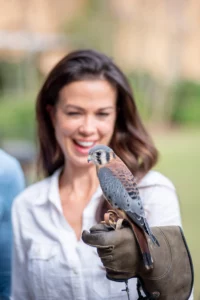

Falconry in the U.S. was more about possessing the birds rather than hunting in the early 20th century. At the beginning of World War II, there were less than 200 falconers in the U.S. Today, there are far more in a sport that is closely monitored. The North American Falconers Association has 2,000 members, and falconry is the most regulated sport in the U.S.
Falconry is legal in all states except Hawaii and raptor possession is restricted. Falconers cannot keep birds of prey as pets, for captive-breeding purposes, or for shows or activities like Renaissance fairs, according to U.S. law. Arndt’s falconry class is one of the few opportunities the public has to try falconry.
The peregrine I coaxed onto my glove at the culmination of the two-hour class was once an endangered species in the U.S. It was falconers who saved this powerful bird from extinction.
Falconry has evolved over time, from hunting to sport to predatory bird abatement at airports, California vineyards, and hotels like The Ritz-Carlton Orlando, Grande Lakes. At the luxury hotel, 15 minutes from Orlando International Airport, Arndt and his falcons helped catch 60 squirrels over a four-week period to help eradicate an unnatural problem with squirrels who were bothering guests at the resort’s pool.
Educational classes like Arndt’s are a powerful reminder of falconry’s importance and relevance today. As I took a final photo with the peregrine falcon, who was flapping his wings in the wind, and I felt the strength of the bird’s grasp on my wrist, I finally understood the allure of this living cultural heritage that continues to take flight.
* Thank you to the Grande Lakes, Orlando for allowing us to use their professional photos for our publication.

